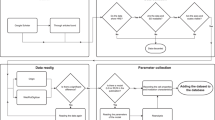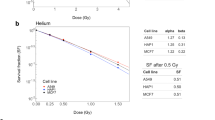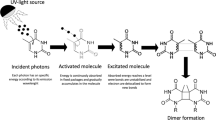Abstract
WHEN exposed to ionizing radiation, bacterial strains which are deficient in ability to by-pass or repair damage to nucleic acid have lower oxygen enhancement ratios (OERs) than their more radioresistant parents1. This was predicted from a model in which the principal responsibility for the oxygen effect is attributed to a primary lesion of “type O”, whereas a different primary lesion, “type N”, is more easily repaired or by-passed by some strains than others. With certain strains, notably Escherichia coli B, the lethal effects of type N lesions are readily modified by post-irradiation culture conditions. The greater the extent of repair of type N damage, the higher the OER2,3.
This is a preview of subscription content, access via your institution
Access options
Subscribe to this journal
Receive 51 print issues and online access
$199.00 per year
only $3.90 per issue
Buy this article
- Purchase on Springer Link
- Instant access to full article PDF
Prices may be subject to local taxes which are calculated during checkout
Similar content being viewed by others
References
Alper, T., Mutation Res., 4, 15 (1967).
Alper, T., Intern. J. Radiat. Biol., 3, 369 (1961).
Alper, T., Phys. Med. Biol., 8, 365 (1963).
Hill, R. F., and Feiner, R. R., J. Gen. Microbiol., 35, 105 (1964).
Wills, E. D., and Wilkinson, A. E., Radiat. Res., 31, 732 (1967).
Allison, A. C., and Paton, G. R., Nature, 207, 1170 (1965).
Allison, A. C., Magnus, I. A., and Young, M. R., Nature, 209, 874 (1966).
Pollard, E. C., and Weller, P. K., Radiat. Res., 31, 617 (1967).
Davies, D. R., Nature, 215, 829 (1967).
Alper, T., Brit. J. Radiol., 27, 50 (1954).
Bachofer, C. S., and Pottinger, M. A., Science, 119, 378 (1954).
Kimball, R. F., Ann. NY Acad. Sci., 59, 638 (1955).
Author information
Authors and Affiliations
Rights and permissions
About this article
Cite this article
ALPER, T. Low Oxygen Enhancement Ratios for Radiosensitive Bacterial Strains, and the Probable Interaction of Two Types of Primary Lesion. Nature 217, 862–863 (1968). https://doi.org/10.1038/217862a0
Received:
Revised:
Issue Date:
DOI: https://doi.org/10.1038/217862a0
This article is cited by
-
Radioprotection of euoxic bacteria by phenothiazine drugs
Radiation and Environmental Biophysics (1984)
-
Cellular response to membrane-specific drugs and ionizing radiation
Radiation and Environmental Biophysics (1981)
-
Interaction of DNA and liposomes as a model for membrane-mediated DNA damage
Nature (1977)
-
Absence of oxygen effect for induction of resistance to ionising radiation
Nature (1976)
-
Oxygen effect onγ-irradiated DNA
Radiation and Environmental Biophysics (1974)
Comments
By submitting a comment you agree to abide by our Terms and Community Guidelines. If you find something abusive or that does not comply with our terms or guidelines please flag it as inappropriate.



